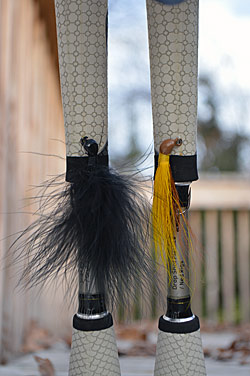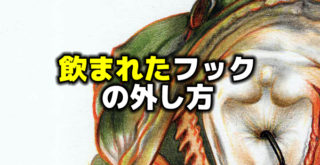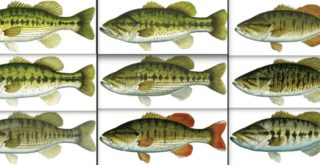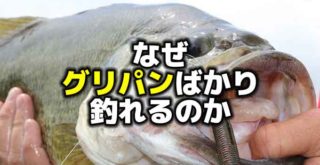セス・フェイダー:ヘアージグで釣るスモールマウスバス

Photo by bassresource.com
こんにちは!店長の小山です!
本日は海外サイトより、”Hair Jigs Are Versatile Smallmouth Catchers”という記事を引用してご紹介いたします。
引用先:bassresource.com”Hair Jigs Are Versatile Smallmouth Catchers”By Pete M. Anderson(海外サイトです)
このブログでは時々、スモールマウスバス攻略の武器として、アメリカでは割りとスタンダードであるヘアジグについて紹介しています。
https://nojiriko-fishing.net/%E3%83%98%E3%82%A2%E3%82%B8%E3%82%B0%E3%82%92%E3%81%94%E5%AD%98%E7%9F%A5%E3%81%A7%E3%81%99%E3%81%8B/
これまで私が見てきた情報の中では、アメリカ国内においてエアジグの位置づけとしては低水温期の必殺ルアーとして登場してくることがほとんどでした。
また、急な低水温状態や濁りが入ったりして一時的にタフになってしまった状態など、何をやってもダメな時の切り札的な存在であるような扱いをされていることも多かったのです。
それならば、日本でも晩秋のころからかなり手ごわくなってしまうスモールマウスバスを相手にするときなど、これは試す価値がありそうだということで、このブログでいくつか紹介させていただいてきたわけですが、今回のこの記事、スモールマウスバスハンターとしてアメリカで名高いバスマスター・エリートプロのセスフェイダー氏によると、どうやらヘアジグの出番はタフってしまった時だけでは無いようです。
アメリカのバスフィッシング専門メディア「Bass Resource」のこの記事では、セスフェイダーが普段からヘアジグの使い分けでどうスモールマウスバスを釣っているのかということが書かれています。
スモールマウスバスハンターのトッププロのヘアジグのお話しです。ぜひ読んでみましょう。
マラブージグ
Feider packs hair jigs when he hits the road with the Elite Series. While he’s caught some spotted bass at Southern stops and largemouth all over with them, he said they work best for shallow smallmouth in spring and early summer. “In clear water, especially when it’s not super windy,” he said.
It’s not only time of year and conditions that Feider is particular about when fishing a hair jig. He only fishes with ones tied with marabou, feathers most often taken from chickens and turkeys. With a sturdy quill that easily ties into a jig, their fluffy plume ripples with the slightest motion, making the jig look alive underwater. “It’s the most subtle thing,” he said.
That action makes marabou jigs a good imitator of baitfish and insects such as mayflies. “It will catch big ones, but it is more of a numbers bait,” Feider said. He has caught smallmouth up to 6 pounds on one. “You’re going to catch all of them,” he said. He likened it to fishing a stick worm such as a Yamamoto Senko. As you fish along, every bass that sees it will bite it. “You just have to keep catching them, and eventually you will catch a big one,” he said.
Feider designed a marabou jig — Feider Fly — for Outkast Tackle when he couldn’t find a production model that he liked. “The hook is really important,” he said. It needs to be super sharp to penetrate with minimal effort and large enough to hold a powerful smallmouth. His go-to weight is 3/32 ounce, and he never fishes one heavier than 1/8 ounce. In extremely shallow water, he’ll drop down to a 1/16-ounce model. The light weight makes it easier for him to fish, which in this case, isn’t on bottom.
Feider swims his marabou jig slow and steady like a small swimbait, leaving out the hops and twitches that are the mainstays of fishing most hair jigs. He aims his casts so his retrieves track across rock-sand transitions. The only time he alters his retrieve is when it crosses a key piece of cover such as a boulder or log. Then he’ll let his jig pendulum down to it, hoping to entice any smallmouth that might be hiding there.
While the retrieve is subtle, Feider said some strikes can be aggressive, producing a telltale sharp tap. Most others involve a smallmouth inhaling the jig and swimming along with it. He describes their feel as his jig becoming heavier or reel binding. That’s why a premium spinning reel is vital for this technique. He said its smoothness makes strikes more distinguishable.
The correct line and rod help generate strikes. Feider fills his spinning reel with 6-pound test braided line, which has a diameter equivalent to 1- or 2-pound test monofilament. It’s less visible in clear water and easy to cast. He adds a 6- to 7-foot leader of fluorocarbon line to its end using an FG knot, which weaves the main line around the larger diameter leader. He said it’s extremely strong, and it needs to be. In order to generate casting distance with the light-weight jig, he deeply loads his rod — a medium light, fast action 7 ½-footer he designed for Daiwa’s Tatula Elite line — before whipping it forward.
Rod speed is one factor in a long cast. “You have to get the jig wet before you can cast it,” Feider said. Marabou holds water like a sponge, and every drop adds weight. He adds more by slipping a half-inch piece of Senko onto the hook, locking it with the keeper he incorporated into the Feider Fly’s design. While it can be a piece of any soft-plastic lure, his choice comes down to salt content. Senkos have a lot, he said, which makes them heavier than the same sized piece of salt-free plastic.
Feider matches the color of his Senko piece to his jig, which is almost always black. That way, after you’ve caught a bunch and the marabou feathers start to get a little beat up, it blends in.
フェイダーは、エリートシリーズのツアーに出かけるとき、ヘアジグを積みます。彼はそれらを使って南部のスポッテッドバスやラージマウスバスを次々とキャッチしましたが、春から初夏のシャローのスモールマウスで最高のパフォーマンスを発揮すると言います。「クリアウォーターで、特に風が強くないときが最高だ」と彼は言います。
フェイダーがヘアジグで釣るときというのは、気難しい時期やコンディションの時だけではありません。彼はマラブー(の羽根)が結ばれた物で釣りますが、その羽根は多くがニワトリや七面鳥から取らています。ジグに簡単に結びつけることができる丈夫な羽毛であり、ふわふわとした羽根がわずかな動きで波動を出し、水中でジグを生き生きと見せてくれます。 「これは最も繊細なものです」と彼は言います。
マラブージグのそのアクションは、ベイトフィッシュやメイフライのような昆虫をうまく模しています。 「これはビッグフィッシュを釣ることもできますが、数釣りもできるルアーです。」と、フェイダーは言います。彼はこれひとつで6ポンドまでのスモールマウスを釣りました。 「これは全部釣りきってしまうはずだ。」と彼は言います。ゲーリーヤマモト・ヤマセンコーのようなスティックワームを例に出します。それで釣りをしている間、それを見たすべてのバスはそれにバイトするでしょう。 「あなたはこれで数を釣っているうちに、ついにはビッグフィッシュが混じるでしょう。」彼は言います。
フェイダーは、自分が気に入るモデルが市販されていないということで、Outkast Tackleで「Feider Fly(フェイダーフライ)」というマラブージグを作りました。 「フックは本当に重要です。」と彼は言います。パワフルなスモールマウスに耐えるのに十分な強度でありつつ、最小の力で貫通させるには超シャープでなければなりません。彼のよく使うウエイトは3/32オンスで、1/8オンスよりも重いもので釣ることは決してありません。シャローウォーターでは1/16オンスを使います。この釣りはボトムを釣るものではないため、その軽さが釣りをするのをより簡単にしています。
フェイダーは、マラブージグを小さなスイムベイトを扱うようにスロー&ステディリトリーブで使い、ヘアジグを使うときのメインのテクニックであるホップやトゥイッチはしません。彼はボトムが岩から砂へ変わるところを横切るようにリトリーブするようにキャストします。彼が唯一リトリーブに変化を付けるのは、大岩や丸太のような重要なカバーを通過するときです。そこで彼はそこに隠れているであろうスモールマウスを誘うため、ジグをカーブフォールさせます。
フェイダーは、リトリーブが繊細である一方で、バイトの出方はアグレッシブで、鋭いアタックを生み出すと言います。ほとんどの場合、スモールマウスはジグを追ってきて一気に吸い込みます。彼はジグが重くなったり、リールを巻く手が止まるのだと説明します。そのため、このテクニックでは高品質なスピニングリールが不可欠です。彼はその滑らかさがバイトをより判別しやすくすると言います。
正しいラインとロッドもバイトを生み出すのに役立ちます。フェイダーは、スピニングリールに6ポンド(0.6号程度)のPEラインを巻きます。このPEラインの細さは、1ポンドから2ポンドのナイロンに相当します。クリアウォーター下でも見えにくく、キャストするのも簡単です。彼は6フィートから7フィートのフロロカーボンのリーダーをFGノットで結び、より太い直径のリーダーをメインラインに編み込みます。彼はそれが非常に強く、必要であると言います。軽量のジグで飛距離を出すために、彼はダイワのタトゥーラ・エリートの7.5フィートのミディアムアクション、ファーストテーパーロッドを多用します。
ロッド選びはロングキャスト性能が1つの要因です。 「キャストする前にジグを濡らします。マラブーはスポンジのように水を貯くわえ、水によって重くなります。彼はさらに、ヤマセンコーを半インチに切ってフックに挿し、フェイダーフライのワームキーパーにロックすることでさらにウエイトを追加します。ワームであればなんでも良さそうですが、彼の選択は塩が含まれているかどうかによります。 「センコーにはたくさんの塩があり、同じ大きさの塩のないワームより重くなっているのです。」と彼は言います。
フェイダーがセンコーをジグに挿すときのカラーはだいたい決まっています。ほとんどの場合は黒です。そしてそれはほとんどジグの色と同じになります。そしてマラブージグでさんざん叩き、多くの魚を釣ったのちに、いろいろ試してみます。

Photo by bassresource.com
バックテールジグ
Feider has proven the productivity of marabou jigs. But they aren’t the only ones that catch smallmouth. Bucktail, which is what most bass anglers associate with hair jigs, will produce under the right conditions.
Bucktail doesn’t pulsate like marabou. Its hollow fibers create more of a quiver at rest. They slick back when moved through the water, giving the jig a gliding fall. It holds its shape when tied, so thin and wispy or big and bulky jigs are possible. Where a particular jig falls on that spectrum determines the amount of flair at rest, how fast it sinks, and how it darts with each hop.
Bucktails are a good choice when smallmouth are holding in deep water — 10 or more feet — or swimming in cold water. Their lack of resistance means they sink fast and stay where you cast them, regardless of the current. And their subtle action won’t turn off timid bass.
Most bucktails weigh 1/2 ounce or less. Heavier ones are available, but those are mostly used for stripers or in saltwater. Ones weighing 1/8 to 1/4 ounce will cover most smallmouth fishing conditions. You’ll be best served by throwing them on a 7-foot medium spinning rod. Fast action rods are crisp enough to launch these jigs and set the hook at the end of a long cast or in deep water.
Like with Feider’s marabou jig, you’ll want to use braid and a fluorocarbon leader. The zero-stretch and small diameter braid will help you feel light bites and isn’t affected by current as much as a full length of fluorocarbon or monofilament line.
The amount of action you add to a bucktail depends on the situation. When smallmouth are active, you can add plenty of big hops. In cold water, it might take small twitches or even sliding it across the bottom to generate strikes. You’ll have to experiment to uncover which one works best. Don’t forget to try different lengths of pauses. Sometimes letting it sit motionless will make them bite, too.
When it comes to color, stick to natural hues — those that contain brown, black or white — and match the hatch. They also complement the natural action of a bucktail jig. If you’re on a Northern fishery, for example, try brown to match crawfish or small chubs or suckers. Use a white jig to imitate the shad that smallmouth eat in Southern reservoirs. And don’t worry if you can’t find the exact color you need. Tying your own is a simple process. A surprisingly small selection of materials and tools can lead to an infinite number of variations.
フェイダーはマラブージグの有効性を証明しています。しかし、それはスモールマウスを釣る唯一の方法ではありません。バックテールジグは、ほとんどのバス釣り人がヘアジグと聞いて連想するものであり、適切な条件下ではかなり有効です。
バックテールジグはマラブーのように波打ちません。中空の繊維により、停止している時により多くのゆらめきを作り出します。ジグが水中を動いている時はヘアが後ろへなびき、グライディングフォールももたらします。これはタイイングされたときの形を保持するため、細く束ねられた形になりますが、大きくバルキーなジグにすることも可能です。そのジグがどれくらいの速さでフォールするか、ホップした時にどれくらいダートするか、ポーズ時にどれくらい毛がフレアするかが決めた範囲内になったかどうかで、どれくらいの量を巻くかが決められます。
バックテールジグは、スモールマウスが3メートル以上のディープにいる場合や、低水温時に泳がせる場合に適しています。ジグに抵抗がないということは、流れなどに影響されず、速く沈み、あなたがキャストした場所にとどまることを意味します。そしてその繊細なアクションは臆病なバスを怖がらせません。
大部分のバックテールジグの重さは1/2オンス以下です。もっと重いものもありますが、その多くはストライパーやソルト用に使われています。 1/8〜1/4オンスのウエイトは、ほとんどのスモールマウスバス釣りの条件にマッチします。キャストするには7フィートのミディアムのスピニングロッドが最も適切でしょう。ファーストアクションのロッドは、ジグをロングキャストしディープゾーンでの充分なフッキングを可能にします。
フェイダーのマラブージグと同様に、PEとフロロリーダーを使用するのがいいでしょう。伸びがなく細いPEラインは、わずかなバイトを感じ取り、フロロカーボンやナイロンラインをメインラインにしたときのような流れの影響を受けません。
バックテールジグに与えるアクションの量は状況によって異なります。スモールマウスがアクティブなときは、大きなホップを多く入れます。低水温下では、わずかなトゥイッチを入れるか、ボトムを滑らせてバイトを生み出すでしょう。どれが一番有効かを明らかにするためには試してみないと分かりません。ポーズの長さを変えてみるのを試してみることを忘れないでください。時にはまったく動かないようにするとバイトがあるかもしれません。
カラーに関しては、ブラウン、ブラックまたは白を含むナチュラルカラーまたはマッチザベイトとなるように心掛けてください。そういった色合いが、バックテールジグのナチュラルアクションを補います。たとえば、アメリカ北部のフィールドの場合は、ザリガニや小さなチャブやサッカー(ともにアメリカ北部のコイ科の魚)に合わせてブラウンカラーを試してみてください。南部のリザーバーのスモールマウスが食べているシャッドを模すときは、白いジグを使用して下さい。どんなカラーが必要なのか、正確な色を見つけることができない場合も心配しないでください。ジグを結ぶこと自体はとても簡単なプロセスです。色々なカラーをの中から選ぶことは、無限のバリエーションにつながります。
いかがでしたか。
ヘアジグというルアーの構成は、ヘッド、フック、毛のみという、見るからにシンプルなルアーですが、それだけに、非常に多才で繊細な部分もあるようです。
大きく分けると、マラブージグ(鳥の羽毛のジグ)は基本的にスローなステディリトリーブ、バックテールジグ(鹿の尻尾の毛のジグ)はステイでの食わせやホップでのダート、フォールでのリアクション狙いが含まれるといった感じでしょうか。
また、トレーラーとしてセンコーなどを使うのも興味深い点です。これで飛距離を稼いだり沈下率を調節したりするんですね。
私も先日、ヘアジグを試してみたのですが、1/8オンスというウエイトながらかなりの飛距離が出て、よく沈み、水中での見た目が非常にナチュラルでした。使い方がいまいちよくわかっていなかったのですが、この記事を読んで、より一層釣りたい欲が高くなってしまいました(笑)
日本のバスプロさんの記事ではなかなかヘアジグの記事が出てきませんので、いろいろテストしてみるほかなさそうですが、プロの方でなくてもすでに使いこなしている方も多いようで、みなさんの研究心は本当にすごいと思います。
ちなみに当店では現在、次のヘアジグがございます。
これは1パック2個入りで大変お得なセットです。私もこれを使っていますが、ラインアイの位置がいいのか、簡単に水平スイミングができます。早く釣りたいところです!
バーチカルに落としても水平姿勢でいますので、シューティング的に使ってもいいでしょう。
こちらはやや重い1/4ozということで、夏から秋のディープからスーパーディープを攻略するか、シャローからミドルレンジを素早く通していくような使い方がメインになりそうです。
このヘアージグはマラブーとバックテールのミックスですので、スイミング、ポーズ、フォールと色々な使い方ができるという感じでしょうか。
私としても早くみなさまに良い情報がお伝えできるように、なんとか1本、ヘアジグで釣りたいなと思っています。
よろしければ皆様も、新しい釣り方にチャレンジしてみて下さいませ。
それでは、また。
毎度ありがとうございます!






























